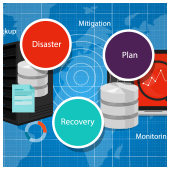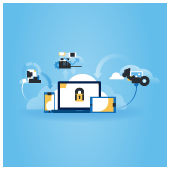 Failing to stop a cyber attacker, or to pass a disaster recovery plan (DRP) audit could be the product of focusing your efforts on the wrong educational resources. Because no matter how many conferences you attend, or how many certifications you receive, nothing beats real-world case studies. If that’s what you’re looking for, a state government office just gave us plenty to pore over. See for yourself.
Failing to stop a cyber attacker, or to pass a disaster recovery plan (DRP) audit could be the product of focusing your efforts on the wrong educational resources. Because no matter how many conferences you attend, or how many certifications you receive, nothing beats real-world case studies. If that’s what you’re looking for, a state government office just gave us plenty to pore over. See for yourself.
Hosting certain types of data, or managing a government network, legally binds you to maintain DRPs. After an audit of the Michigan Department of Technology and Budget, several failures lead to a trove of helpful tips for small- and medium-sized businesses attempting to create a bulletproof disaster recovery plan.
Update and test your plan frequently
One of the first and most obvious failures of the department’s DRP was that it didn’t include plans to restore an essential piece of their infrastructure. The plan didn’t include steps to restore the department’s intranet, which would leave employees unable to complete even the most basic of tasks.
The reason for the oversight? The last time the plan was updated was in 2011 — leaving out more than six years of IT advancements. If annual revisions sounds like too much work, just consider all of the IT upgrades and improvements you’ve made in this year alone. If they’re not accounted for in your plan, you’re destined to fail.
Keep your DRP in an easy-to-find location
It may seem a bit ironic that the best way to store your top-of-the-line business continuity solution is in a binder, but the Michigan Department of Technology and Budget learned the hard way that the alternatives don’t work. Auditors found the DRP stored on the same network it was meant to restore. Which means if something had happened to the network, the plan would be totally inaccessible.
Your company would do well to store electronic copies on more than one network in addition to physical copies around the office and off-site.
Always prepare for a doomsday scenario
The government office made suitable plans for restoring the local area network, but beyond that, there was no way for employees to get back to work within the 24-hour recovery time objective.
Your organization needs to be prepared for the possibility that there may not be a local area network to go back to. Cloud backups and software are the best way to keep everything up and running when your office is flooded or crushed beneath a pile of rubble.
DRPs are more than just an annoying legal requirement, they’re the insurance plan that will keep you in business when disaster strikes. Our professionals know the importance of combining both academic and real-world resources to make your plan airtight when either auditors or blizzards strike. Message us today about bringing that expertise to your business.

 Facebook might be the biggest name in social media, but that doesn’t mean it’s the only one. Since there isn’t a one-size-fits-all platform, there are trendier options such as Instagram and Snapchat, with a burgeoning millennial base to choose from. With that in mind, it’s essential for business owners to understand the pros and cons of each platform before settling on one.
Facebook might be the biggest name in social media, but that doesn’t mean it’s the only one. Since there isn’t a one-size-fits-all platform, there are trendier options such as Instagram and Snapchat, with a burgeoning millennial base to choose from. With that in mind, it’s essential for business owners to understand the pros and cons of each platform before settling on one. Do you have security measures in place for your office’s printers? By “security,” we don’t mean locked doors or watchful guards; we’re referring to security against hackers that use printers as a weapon. Despite many companies going paperless, printers are still essential in most offices. And based on recent reports, popular printer brands are targeted for corruption.
Do you have security measures in place for your office’s printers? By “security,” we don’t mean locked doors or watchful guards; we’re referring to security against hackers that use printers as a weapon. Despite many companies going paperless, printers are still essential in most offices. And based on recent reports, popular printer brands are targeted for corruption. As technology consultants, we’re stuck between a rock and a hard place. We want to provide our clients with enterprise-level IT, but that requires that we specialize in overwhelmingly intricate technology. Explaining even the most foundational aspects of our cyber-security would most likely put you to sleep before convincing you of our expertise. But if you really want to know, here are a few summaries of how we focus on proactive strategies rather than reactive ones.
As technology consultants, we’re stuck between a rock and a hard place. We want to provide our clients with enterprise-level IT, but that requires that we specialize in overwhelmingly intricate technology. Explaining even the most foundational aspects of our cyber-security would most likely put you to sleep before convincing you of our expertise. But if you really want to know, here are a few summaries of how we focus on proactive strategies rather than reactive ones. Google’s G Suite or Microsoft’s Office 365? That’s the question. One that many business owners ask themselves but often put aside because weighing the individual functionality seems like a monumental task! We’re here to help end that indecisiveness, so let’s take a look at what each has to offer.
Google’s G Suite or Microsoft’s Office 365? That’s the question. One that many business owners ask themselves but often put aside because weighing the individual functionality seems like a monumental task! We’re here to help end that indecisiveness, so let’s take a look at what each has to offer. Many IT experts predict that more businesses will gravitate towards the Internet of Things (IoT). This statement is hard to dispute considering that smart thermostats and refrigerators are already in widespread use. But internet-connected appliances aren’t the only thing IoT has to offer. Here are four other ways your business can take advantage of this exciting new technology.
Many IT experts predict that more businesses will gravitate towards the Internet of Things (IoT). This statement is hard to dispute considering that smart thermostats and refrigerators are already in widespread use. But internet-connected appliances aren’t the only thing IoT has to offer. Here are four other ways your business can take advantage of this exciting new technology. Scroll, double-tap, repeat, might have been the original Instagram-ing routine, but not anymore. After partnering with global advertising giants, IG is introducing its latest feature: Stories. With it, you can share short videos, or even personally decorated snapshots of your daily life. But many of you might ask, “What does this have to do with online marketing?” Read on and find out.
Scroll, double-tap, repeat, might have been the original Instagram-ing routine, but not anymore. After partnering with global advertising giants, IG is introducing its latest feature: Stories. With it, you can share short videos, or even personally decorated snapshots of your daily life. But many of you might ask, “What does this have to do with online marketing?” Read on and find out.